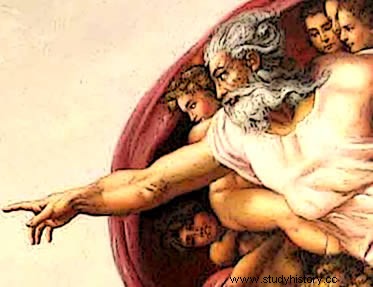
By Rainer Sousa
Despite being conceived as a spiritual and superior being, the God of Christendom has always been the subject of several attempts at representation. Often inspired by the Genesis account, which tells us that we were conceived in his image and likeness, artists have tried to solve this incredible divine mystery. Over time, various manifestations ended up agreeing on a very specific set of characteristics for such a creator of all things.
In the 16th century, the brilliant Italian painter Michelangelo was tasked with painting the frescoes in the Sistine Chapel. In this work, recognized as one of the most prominent manifestations of Renaissance art, he executed the creation of the fresco “The Creation of Adam”, which depicts the exact moment when God established the creation of man. Behind the beauty of the image, we can perceive interesting religious notions about the divine figure.
The image of God created in Michelangelo's work has a set of well-defined characteristics. We perceive the construction of a masculine image, senile, but at the same time displaying a vigorous and active physical condition. In this conjunction of elements, one can perceive much more than a simple subjective choice. As an artist, we can see that the author of this work was clearly influenced by biblical accounts that describe or speak of God himself.
The figure of an “old god” commune perfectly with some passages that use alternative expressions to refer to God. In several passages of the Old Testament, we observe the divine figure being called by the expression “the ancient of days”. This allegory's primary function is to reinforce the idea of God as the creator of the world and, as a spiritual creature, would exist long before man or the world itself came into being.
Furthermore, valuing an important aesthetic prerogative of the Renaissance, we observe that Michelangelo's God is projected towards the first conceived man. In this sense, the impression of movement values the idea that God is a being of great powers that directly affect human existence. The pointed finger detail promotes a sense of balance between the two parts of the fresco. The outstretched arm values the association between God and his creative power.
Finally, on what biblical values would this corpulent and masculine representation of God be based? In this regard, we must turn to the different moments in which the biblical narrative thematizes God's relationship with the Hebrew nation. In various situations, divine supernatural powers intercede in victory against some foreign enemy nation. With this, the feeling of a warrior and powerful god ends up influencing the preference to associate God with a man with a large physical size.
In this way, we realize that the dialogue between art and religious belief establishes relationships that often go unnoticed. Undoubtedly, we cannot fail to say that some of these elements explored in Michelangelo's painting ended up being internalized by many of the Christians around the world. After all, who never imagined the divine figure in a similar way?
